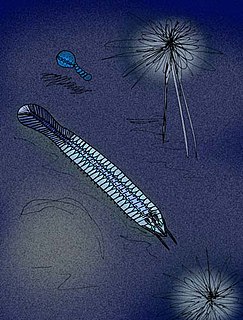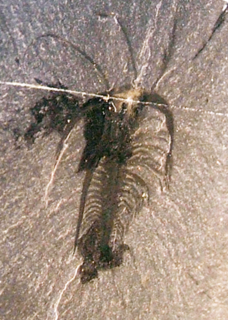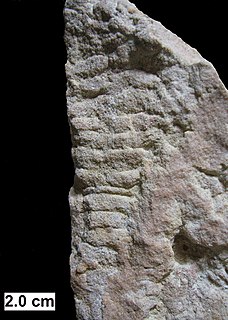 W
WCyclopites is a genus of aglaspidid arthropods that lived in shallow seas in what is now Wisconsin during Late Cambrian times. It is distinguished from other aglaspidids by the extreme proximity of its eyes. The genus earns its name from this presence of what might appear to be a single, central eye.
 W
WHabelia is an genus of extinct arthropod from the Middle Cambrian. Its fossils have been found in the Burgess Shale in British Columbia, Canada. Fifty-four specimens of Habelia are known from the Greater Phyllopod bed, where they comprise 0.1% of the community. While previously enigmatic, a 2017 restudy found that it formed a clade (Habeliida) with Sanctacaris, Utahcaris, Wisangocaris and Messorocaris as a stem-group to Chelicerata.
 W
WKleptothule rasmusseni is a small, elongated trilobite, about 3 cm in length, and about 5 to 6 mm in width, from the Sirius Passet Lagerstätte. It is currently placed in the family Nevadiidae, though this may change with further study.
 W
WMarrella is an extinct genus of arthropod known from the middle Cambrian Burgess Shale of British Columbia. It is the most common animal represented in the Burgess Shale.
 W
WMosineia is a genus of euthycarcinoid arthropods that lived on tidal flats of Laurentia at what is now central Wisconsin from the Middle Cambrian to the Late Cambrian. It contains a single species, Mosineia macnaughtoni. Associated trace fossil evidence suggests that this genus spent some of its time subaerially, possibly to mate and to feed on the microbial mats that blanketed the beaches. The genus is named after Mosinee---the city in Marathon County, Wisconsin, near which the fossils were found. The collecting site is known as Blackberry Hill, which is a well known Konservat-Lagerstätte that produces abundant exceptionally preserved fossils.
 W
WOdaraia is a genus of crustacean arthropod from the Middle Cambrian. Its fossils, which reach 15 centimetres (5.9 in) in length, have been found in the Burgess Shale in British Columbia, Canada. 217 specimens of Odaraia alata are known from the Greater Phyllopod Bed, where they comprise 0.41% of the community.
 W
WWaptia fieldensis is an extinct species of arthropod from the Middle Cambrian Burgess Shale Lagerstätte of Canada. It grew to a length of about 8 cm (3 in) and resembled modern shrimp in both morphology and habit. It had a large bivalved carapace and a segmented body terminating into a pair of tail flaps. It was an active swimmer, feeding on organic particles it gathered from the seafloor substrate. It is also one of the oldest animals with direct evidence of brood care.